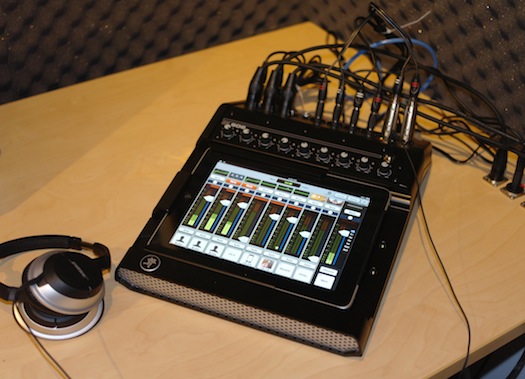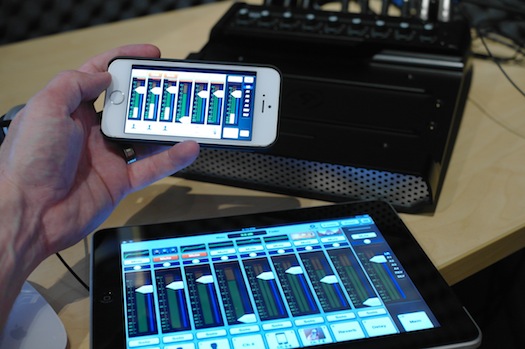The technology around the way we do audio has changed fundamentally in recent years, from the small form factor remote recording technology to the advanced digital studio desks we’ve been seeing in studio installations for the last decade it really does create a new level of power and flexibility for users.
Those changes continue even in small form factor audio desks which radio stations around the country often use in Outside Broadcast or small studio installations. This week I came across and installed something I never dreamed I would see, a mixer with a full iPad control surface and wireless control on up to 10 iOS devices.
As someone who does a lot of radio interviews and several weekly podcast from my own studio, I have a simple setup in radio terms but complex in the scheme of home podcast studios. Three microphones, a ‘hotkeys’ input (using iPad as sound trigger), and hybrid phone in/out. Plus headphone audio distribution to three positions in the studio.
I had been using a $250 eight channel Behringer XENYX 1204. Great unit. For me though, as an audio novice – the dials and knobs meant nothing so I’m pretty sure I never really got the most from it.
The new Mackie DL806 has changed all that. And given me so much flexibility. After setting it up and putting it through its paces I think this is a great solution for Radio OB’s, functions and no doubt for live band events. I’ll focus my thoughts and reasoning on the Radio OB’s though for now.
What you have here is 8 input channels (there is a 16 channel option also). Inside are 8 Onyx mic preamps, Cirrus logic converters, 4 aux sends for monitor mixes and a master L/R output for mains.
The box when you get it seems bare – no faders, just your eight inputs, four 6.5mm aux outputs and the two XLR L/R outputs, plus a headphone jack and gain controllers for all eight inputs.

Where you would normally see faders, dials and knobs for settings is a blank space.
Power it up (lockable power connection) and plug into your network (or a Single simple router) and you’re off and running.
Next up, you download the “Master Fader” app for iPad. Slide your iPad into the dock and hey presto you have a virtual control panel. It’s amazing. Fader control where anything you touch grows and glows for easy access and understanding of what you’re doing.
I honestly can’t begin to understand what this thing is capable of or the controls it has. However if you take some time to view the Mackie YouTube tutorials and look at the configurations you’ll see it is almost fully customisable. EQ controls are touch and slide, operating across the four bands of each channel. You can also switch to a “vintage” look with dials taking the place of the digital settings.
Swipe up on the channel settings and you’re controlling the gate and compressor for the channel which again can be done in the Vintage mode for those wanting a walk down memory lane. And finally reverb and delay can be controlled on a channel by channel basis.

You can allocate preset EQ settings to any channel from a range of pre-installed options which makes a simple setup so much moreso.
Each layout can be saved and recalled later if you have multiple uses for the device meaning different shows and uses don’t need to operate separately.
Each fader/channel can have a unique name associated with it, or an icon and even a photo to make things super easy.
You can hide unwanted channels, group mono channels together at a click of a button and so very easily control the various aux outputs with a simple swipe.
Perhaps most powerfully, you can have up to 10 devices using the app and controlling the mixer.
Why? Well for a band you might choose to have an iPhone at each position so the musician can control their monitoring and levels.
At a radio OB I can 100% imagine the mixer being out of sight and out of mind of the broadcaster, while on the desk in front of them sits an iPad. Removed from the view are all the unwanted channel controls – so you can take away their ability to change levels on certain things, plus you can allow each user to control some things and not others. Perhaps restrict all the settings on a channel but allow only the control of the levels.
This is so powerful you won’t know what you can do with it until you have a look.

The price is the only real barrier here. The eight channel version will set you back around $1150, while the 16 channel version is more likely $1500. Plus you need an iPad to get it working.
It’s not cheap, but my lord its powerful, easy and an amazing piece of modern studio technology.
Technology Review by Trevor Long, for radioinfo.

